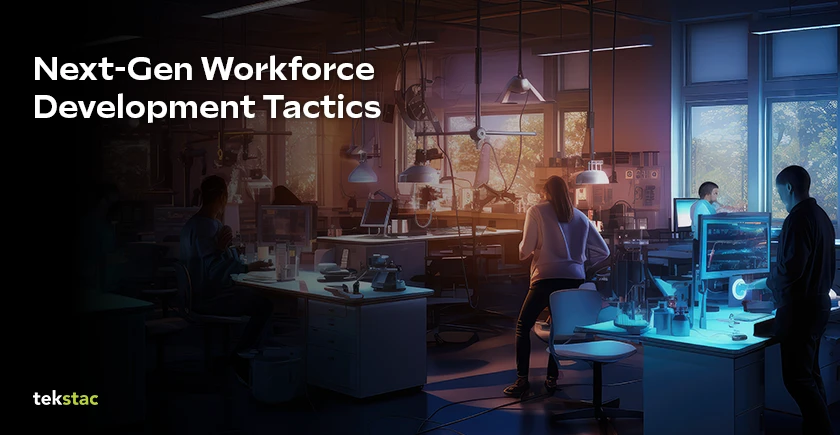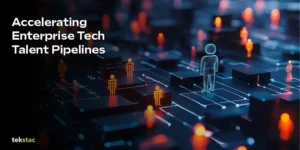7 Proven Workforce Development Strategies to Implement in 2026

Why Most Workforce Development Strategies Fail in 2026
If more than 90% of employees say they’d stay longer at a company that invests in their career, why are so many still leaving?
The answer is simple. Most workforce development strategies are not working. They’re well-intentioned, but too generic, reactive, or completely disconnected from what employees need to grow—and what the business needs.
Organizations are spending time and money on learning initiatives. Over half of them list upskilling and reskilling as a top priority. However, only 21% believe their efforts are practical. While this internal pressure causes misalignment, external pressure is mounting.
With AI and automation expected to disrupt nearly half of all jobs in the coming years, most organizations still lack access to the right resources.
This is the gap companies need to close, and in this blog, we’ll discuss exactly how, with the most effective employee upskilling strategies.
What Makes a Good Workforce Development Strategy?
If we look at the root cause of most ineffective workforce development strategies, we find they’re performative. A few courses here, a new platform there, perhaps some annual compliance training—they rarely drive any change on the ground.
According to the LinkedIn Workplace Learning Report, 94% of employees would stay longer at a company that invests in career development — yet most organizations still struggle to offer structured, measurable workforce development.
In 2026, a good workforce development strategy is built with intention. Let’s see how.

1. It’s centered on future skills, not just “more” skills
Just because employees are learning something doesn’t mean it’s moving the needle. A solid strategy focuses on the adoption and practical use of future-forward skills. The goal isn’t to train for training’s sake. It’s to ensure your workforce is equipped for the shifts across your industry.
2. It prioritizes purposeful, personalized learning
Throwing generic content at employees and hoping it sticks is not a strategy. A meaningful employee upskilling strategy personalizes learning to the employee’s role, growth path, and learning style, while ensuring every resource serves a clear purpose. Whether self-paced modules, peer mentoring, or live sessions, every touchpoint should move the learner (and the business) forward.
3. It connects directly to business outcomes
Learning in isolation won’t drive results. The strongest strategies are mapped directly to business goals: increasing customer satisfaction, enabling digital transformation, or closing leadership gaps.
As always, a good employee development strategy must be measurable. If you can’t track skill development, impact, and progress, you’re just guessing. Additionally, development shouldn’t be a separate activity employees do when they “find the time.” The best strategies are embedded into everyday workflows through feedback, real projects, coaching, and collaboration.
7 Proven Workforce Development Strategies for 2026 and Beyond
As we often notice, some development strategies die quietly after a while, even after allocating training budgets or launching an LMS. If you’re wondering why nothing’s changing on the floor or if you want to take a more innovative approach to workforce development, below are the top 7 workforce development strategies.
1. Future-Back Skill Planning
If your workforce development strategy starts with you looking at current roles and asking, “What’s missing?” you’re already going backward. The smarter question is, “What roles and skills will we need in two years—and how do we build for that now?” Future-back skill planning starts with forecasting future capabilities based on business goals, market shifts, and industry evolution. It requires a partnership between HR, L&D, and leadership to identify skill adjacencies, define learning paths, and bake them into career journeys.
2. Build Company-Wide AI Literacy
With the rise of AI, most companies are excited to invest in GenAI or piloting chatbots. However, employees may still be unaware how exactly it embeds into their work. For example, does your payroll team know how AI affects them? Does your customer service team understand how it’ll change how they work?
AI literacy can’t be just for the IT crowd or the early adopters. Everyone in your company needs to know what AI means for their job — what it automates, what it makes easier, and what it demands from them now.
3. Create Personalized Learning Funnels
Most learning strategies assume people are all starting from the same point, learning in the same way, and aiming for the same goal. This usually ends up in choosing a same course or a learning platform that leave high performers bored and struggling folks overwhelmed.
A better approach would be to build learning journeys like real paths based on where someone actually is, rather than assuming where the employee stands, knows, or wants to go.
4. Make Career Growth Predictable
Ask people how to grow in their company, and most will shrug. Very few know what leads to a promotion or a role switch. This is a big problem. Career paths are usually vague, unspoken, or left to chance. And when there’s no clarity, the same types of people keep getting promoted while others get stuck.
Make growth feel intentional. Start by mapping out what success looks like in each role. Be specific. What skills, outcomes, and behaviors are needed to level up? Don’t keep it locked in a PDF either, bring it into everyday conversations. Managers should reference these paths in check-ins.
5. Use Immersive Learning to Close the Practice Gap
Some traditional L&D strategies run like a school timetable, involving annual plans, quarterly workshops, and calendars. But work doesn’t wait for Q3 to teach you something. It throws new tools, priorities, and challenges at you out of nowhere. When learning doesn’t show up in those moments, people either wing it or stall.
A better way would be to make learning immediate by using microlearning. If someone’s stepping into a new project, give them a quick how-to guide right then. Learning has to move at the speed of change. Otherwise, it’s already too late.
6. Measure Whether People Got Better
Solely looking at whether the employee has completed the course doesn’t help determine if they learned anything. Hence, measure impact. If someone took a negotiation course, are they actually closing deals better? If they were trained on giving feedback, is their team communicating more clearly? Tie learning to actual outcomes — better performance, fewer errors, stronger collaboration.
7. Make Development a Shared Ownership
As we often notice, workforce development gets boxed into L&D or HR. However, real growth happens in the flow of work, driven by managers, shaped by teams, owned by employees. That shift only happens when everyone sees development as their job. Give employees visibility into skill paths. Equip managers to enable growth, not just review it. And get leaders to invest in learning as a lever for business impact. Ultimately, when employee development becomes a shared ownership, it scales.
Empowering Managers to Focus on Strategic Leadership
In many organizations, managers are expected to drive both project outcomes and team development. However, without the right tools, they often struggle to provide consistent, personalized growth opportunities for their teams. This gap can lead to disengagement and high turnover.
The right tools, like Tekstac, address this challenge by offering an AI-powered, end-to-end skilling platform that automates and personalizes the learning journey for each employee.
What Makes Tekstac Different for Workforce Skill Development
With over 500+ curated learning paths covering in-demand tech areas like data analytics, cloud computing, and cybersecurity, Tekstac ensures that employees have access to relevant, up-to-date content.
The platform’s integrated lab environment enables real-time, hands-on practice across various technologies, allowing employees to apply new skills in a controlled setting. Additionally, AI-driven personalization analyzes skill assessments to identify knowledge gaps and recommends tailored learning paths aligned with individual career goals.
Built-In Insights for Managers and L&D Teams
Tekstac provides real-time insights into team progress through intuitive dashboards and analytics. This visibility allows managers to track development, plan interventions, and make informed decisions without micromanaging the learning process.
Ultimately, managers and organizations can focus on strategic leadership and team engagement, confident that their teams are progressing along personalized, goal-oriented learning paths.
Want to apply these workforce development strategies inside your organization? Book a free strategy consultation with our L&D experts.
FAQs on Workforce Development Strategies
1. How do I create a workforce development plan?
Create a workforce development plan by assessing current skills, identifying future skill needs, building training paths to close gaps, assigning ownership, and tracking progress with measurable outcomes.
2. What are the most effective global workforce development strategies?
The most effective global strategies emphasize continuous learning, skills-based career paths, digital skilling, remote-friendly learning platforms, and culturally adaptable training content that support diverse teams.
3. How do you measure the success of workforce development?
Success is measured using KPIs like skill assessments, project outcomes, goal achievement, time-to-productivity, promotion rates, and employee engagement.





